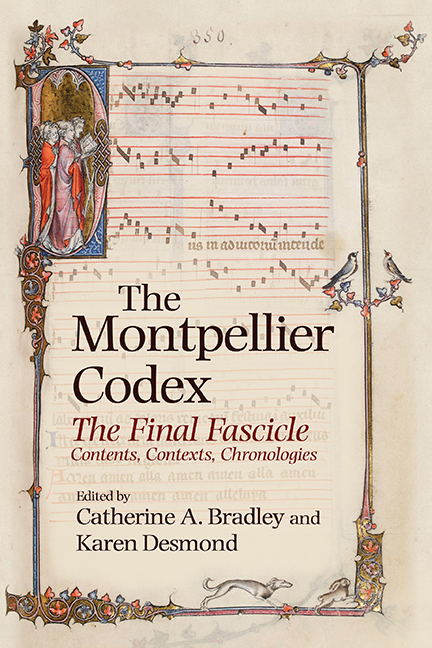Book contents
- Frontmatter
- Contents
- Figures
- Musical examples
- Tables
- Acknowledgements
- List of manuscript sigla
- Abbreviations
- Table of fascicle 8 contents
- Introduction
- I The Material Object
- 1 Montpellier 8: Anatomy of …
- 2 A Palaeographical Analysis of the Verbal Text in Montpellier 8: Problems, Implications, Opportunities
- 3 The Style and Iconography of Montpellier folio 35or
- 4 The Decoration of Montpellier 8: Its Place in the Continuum of Parisian Manuscript Illumination
- 5 Double Motet Layouts in the Montpellier Codex and Contemporaneous Libri motetorum
- 6 Deus in adiutorium Revisited: Sources and Contexts
- 7 Thematic Clusters and Compilational Strategies in Montpellier 8
- II INNOVATION AND TRADITION
- III ANALYTICAL CASE STUDIES
- Bibliography
- Contributors
- General index
- Index of compositions, alphabetical
- Index of compositions in Mo, manuscript order
- Miscellaneous Endmatter
6 - Deus in adiutorium Revisited: Sources and Contexts
from I - The Material Object
Published online by Cambridge University Press: 04 July 2019
- Frontmatter
- Contents
- Figures
- Musical examples
- Tables
- Acknowledgements
- List of manuscript sigla
- Abbreviations
- Table of fascicle 8 contents
- Introduction
- I The Material Object
- 1 Montpellier 8: Anatomy of …
- 2 A Palaeographical Analysis of the Verbal Text in Montpellier 8: Problems, Implications, Opportunities
- 3 The Style and Iconography of Montpellier folio 35or
- 4 The Decoration of Montpellier 8: Its Place in the Continuum of Parisian Manuscript Illumination
- 5 Double Motet Layouts in the Montpellier Codex and Contemporaneous Libri motetorum
- 6 Deus in adiutorium Revisited: Sources and Contexts
- 7 Thematic Clusters and Compilational Strategies in Montpellier 8
- II INNOVATION AND TRADITION
- III ANALYTICAL CASE STUDIES
- Bibliography
- Contributors
- General index
- Index of compositions, alphabetical
- Index of compositions in Mo, manuscript order
- Miscellaneous Endmatter
Summary
Two distinct polyphonic settings of Deus in adiutorium intende laborantium hold places of prominence in various late thirteenth- and early fourteenth-century motet collections. One or both of these settings, notated in score, commonly appear either at the very beginning of a codex or rotulus, or at the beginning of a fascicle. The first of the two settings (hereafter Deus in adiutorium intende I) opens the first fascicle of Mo. It is based on a pre-existing liturgical trope melody, to which it adds two upper voices. The other setting (hereafter Deus in adiutorium intende II), which opens Mo 8, does not appear to use pre-existing chant material. It starts with a cauda and presents newly composed material – typical features of the conductus. How did Deus in adiutorium intende laborantium become such a characteristic opening piece? Or, in Emma Dillon's words, ‘Why was material both stylistically and functionally distinct from the main body deemed a fitting opening?’
While the choice of the different three-part settings of Deus in adiutorium intende in Mo 1 and Mo 8 led Yvonne Rokseth to argue for the eighth fascicle having originally been an independent manuscript,4 Dillon considers this choice to be central to the devotional framework of the whole codex. In her monograph The Sense of Sound, she sees the opening folio of Mo's first fascicle as ‘a miniature devotional exercise, readying the reader to embark on prayer’. The reappearance of the same trope in a different setting at the beginning of the last fascicle completes this experience.
Dillon emphasizes the ‘new media of prayer books’ flourishing during the middle of the thirteenth century. She discusses various examples of books of hours, many of which open with the (untroped) versicle Deus in adiutorium meum intende. This approach, however, does not differentiate clearly enough between the two different instantiations of Deus in adiutorium meum intende and its trope Deus in adiutorium intende laborantium, nor does it take a closer look at the connections between motet collections and books of hours. Thus, Dillon's statement that Deus in adiutorium ‘serves a bibliographic function’ and has a ‘meditative potential – as a ruminative space’ remains slightly vague. More importantly, the geographical patterns of transmission of the different polyphonic settings, as well as the monophonic trope on which one of the two settings is based, have been neglected in this discourse and are considered in more detail in this article.
- Type
- Chapter
- Information
- The Montpellier CodexThe Final Fascicle. Contents, Contexts, Chronologies, pp. 100 - 120Publisher: Boydell & BrewerPrint publication year: 2018



